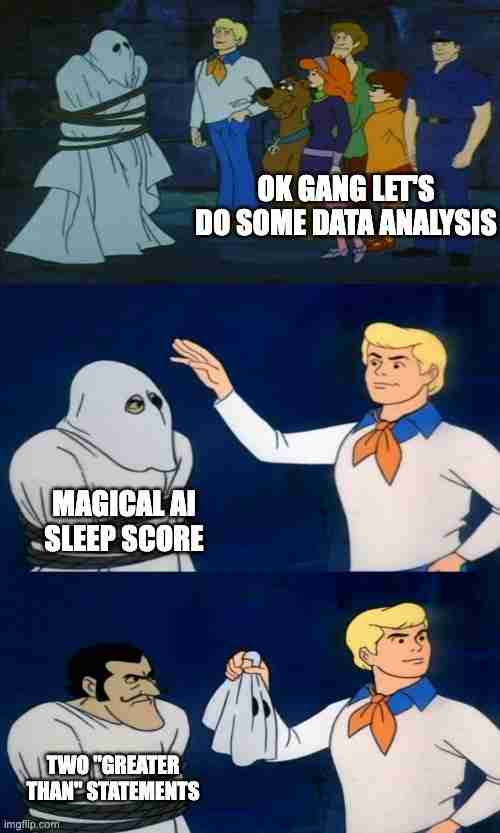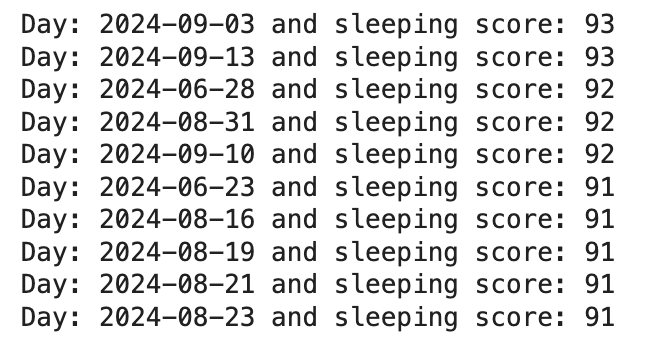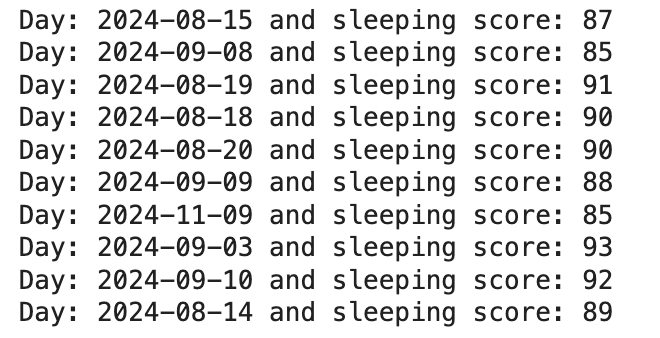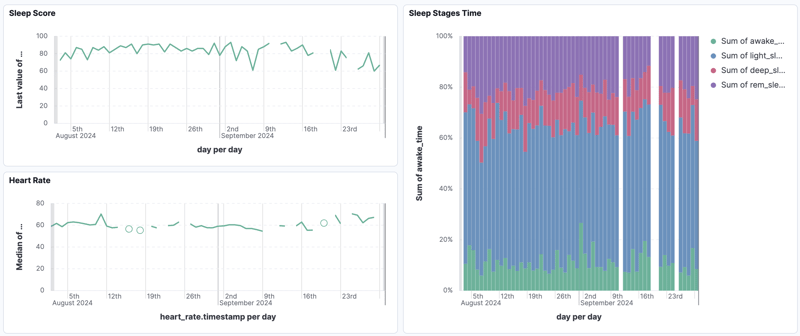Analyzing my Oura sleep score - is it AI or just math?
Today, I delved into my Oura ring's sleep score data, prompting a crucial question: Does this problem require AI, or will a simple formula suffice?

Activity Tracking and the Oura Ring
I'm a data-driven health enthusiast, utilizing fitness trackers like Fitbit and Garmin. However, for everyday wear, I prefer the Oura ring for its discreet design. Sleep tracking is a key feature, making its sleep score worthy of investigation. (For those unfamiliar, Oura's sleep score is detailed on their blog.)
The Enigmatic Sleep Score
A drawback of Oura is its paywalled insights. The free version only displays the sleep score, unlike Fitbit and Garmin's comprehensive dashboards. This raises the question: What makes this sleep score so special, and is the subscription worth it?
The Hypothesis: Simple Correlations
My initial hypothesis, as a data scientist, was straightforward: Higher deep sleep duration and lower average heart rate correlate with better sleep scores. Could it be that simple? Let's find out.
Data Acquisition and Processing
I accessed my Oura data via their developer API, retrieving sleep data and saving it as a JSON file.
def get_data(type):
url = 'https://api.ouraring.com/v2/usercollection/' + type
params={
'start_date': '2021-11-01',
'end_date': '2025-01-01'
}
headers = {
'Authorization': 'Bearer ' + auth_token
}
response = requests.request('GET', url, headers=headers, params=params)
return response.json()["data"]
data = get_data("sleep")
with open('oura_data_sleep.json', 'w', encoding='utf-8') as f:
json.dump(data, f, ensure_ascii=False, indent=4)This data was then indexed in Elasticsearch for easy querying. The JSON structure simplified this process, requiring no extra mapping or data cleaning.
client = Elasticsearch(
cloud_id=ELASTIC_CLOUD_ID,
api_key=ELASTIC_API_KEY
)
index_name = 'oura-history-sleep'
# ... (Elasticsearch index creation and data loading code) ...The Experiment: Simple Queries
My experiment involved simple queries to test my hypothesis. I first sorted days by highest sleep score:
response = client.search(index = index_name, sort="readiness.score:desc") # ... (Code to print day and sleep score) ...

Examining these high-scoring days revealed consistent patterns in deep sleep and heart rate. Then, I built an Elasticsearch query filtering for deep sleep over 1.5 hours and heart rate under 60 bpm, sorted by REM sleep:
query = {
"range" : {
"deep_sleep_duration" : {
"gte" : 1.5*3600
}
},
"range" : {
"average_heart_rate":{
"lte" : 60
}
}
}
response = client.search(index = index_name, query=query, sort="rem_sleep_duration:desc")

The results strongly correlated with the initial high-score days. While not perfect, this demonstrates the predictive power of a simple formula. Further Kibana visualizations (shown below) reinforce this connection.

The Significance
In the hype surrounding AI, it's easy to overlook simpler solutions. This sleep score, often presented as a complex AI achievement, is essentially based on a straightforward formula. This highlights the importance of understanding when simpler methods are sufficient – leading to more accurate, cost-effective, and easily interpretable results. This underscores the enduring value of data science fundamentals and intuitive modeling. While advanced technology is impressive, knowing when not to use it is equally crucial.
See full code notebook here.
The above is the detailed content of Analyzing my Oura sleep score - is it AI or just math?. For more information, please follow other related articles on the PHP Chinese website!

Hot AI Tools

Undresser.AI Undress
AI-powered app for creating realistic nude photos

AI Clothes Remover
Online AI tool for removing clothes from photos.

Undress AI Tool
Undress images for free

Clothoff.io
AI clothes remover

Video Face Swap
Swap faces in any video effortlessly with our completely free AI face swap tool!

Hot Article

Hot Tools

Notepad++7.3.1
Easy-to-use and free code editor

SublimeText3 Chinese version
Chinese version, very easy to use

Zend Studio 13.0.1
Powerful PHP integrated development environment

Dreamweaver CS6
Visual web development tools

SublimeText3 Mac version
God-level code editing software (SublimeText3)

Hot Topics
 Python vs. C : Applications and Use Cases Compared
Apr 12, 2025 am 12:01 AM
Python vs. C : Applications and Use Cases Compared
Apr 12, 2025 am 12:01 AM
Python is suitable for data science, web development and automation tasks, while C is suitable for system programming, game development and embedded systems. Python is known for its simplicity and powerful ecosystem, while C is known for its high performance and underlying control capabilities.
 How Much Python Can You Learn in 2 Hours?
Apr 09, 2025 pm 04:33 PM
How Much Python Can You Learn in 2 Hours?
Apr 09, 2025 pm 04:33 PM
You can learn the basics of Python within two hours. 1. Learn variables and data types, 2. Master control structures such as if statements and loops, 3. Understand the definition and use of functions. These will help you start writing simple Python programs.
 Python: Games, GUIs, and More
Apr 13, 2025 am 12:14 AM
Python: Games, GUIs, and More
Apr 13, 2025 am 12:14 AM
Python excels in gaming and GUI development. 1) Game development uses Pygame, providing drawing, audio and other functions, which are suitable for creating 2D games. 2) GUI development can choose Tkinter or PyQt. Tkinter is simple and easy to use, PyQt has rich functions and is suitable for professional development.
 The 2-Hour Python Plan: A Realistic Approach
Apr 11, 2025 am 12:04 AM
The 2-Hour Python Plan: A Realistic Approach
Apr 11, 2025 am 12:04 AM
You can learn basic programming concepts and skills of Python within 2 hours. 1. Learn variables and data types, 2. Master control flow (conditional statements and loops), 3. Understand the definition and use of functions, 4. Quickly get started with Python programming through simple examples and code snippets.
 Python vs. C : Learning Curves and Ease of Use
Apr 19, 2025 am 12:20 AM
Python vs. C : Learning Curves and Ease of Use
Apr 19, 2025 am 12:20 AM
Python is easier to learn and use, while C is more powerful but complex. 1. Python syntax is concise and suitable for beginners. Dynamic typing and automatic memory management make it easy to use, but may cause runtime errors. 2.C provides low-level control and advanced features, suitable for high-performance applications, but has a high learning threshold and requires manual memory and type safety management.
 Python: Exploring Its Primary Applications
Apr 10, 2025 am 09:41 AM
Python: Exploring Its Primary Applications
Apr 10, 2025 am 09:41 AM
Python is widely used in the fields of web development, data science, machine learning, automation and scripting. 1) In web development, Django and Flask frameworks simplify the development process. 2) In the fields of data science and machine learning, NumPy, Pandas, Scikit-learn and TensorFlow libraries provide strong support. 3) In terms of automation and scripting, Python is suitable for tasks such as automated testing and system management.
 Python and Time: Making the Most of Your Study Time
Apr 14, 2025 am 12:02 AM
Python and Time: Making the Most of Your Study Time
Apr 14, 2025 am 12:02 AM
To maximize the efficiency of learning Python in a limited time, you can use Python's datetime, time, and schedule modules. 1. The datetime module is used to record and plan learning time. 2. The time module helps to set study and rest time. 3. The schedule module automatically arranges weekly learning tasks.
 Python: The Power of Versatile Programming
Apr 17, 2025 am 12:09 AM
Python: The Power of Versatile Programming
Apr 17, 2025 am 12:09 AM
Python is highly favored for its simplicity and power, suitable for all needs from beginners to advanced developers. Its versatility is reflected in: 1) Easy to learn and use, simple syntax; 2) Rich libraries and frameworks, such as NumPy, Pandas, etc.; 3) Cross-platform support, which can be run on a variety of operating systems; 4) Suitable for scripting and automation tasks to improve work efficiency.






